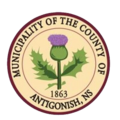Municipality of the County of Antigonish
Antigonish County | |
|---|---|
County Municipality | |
 | |
 Location of Antigonish County, Nova Scotia | |
| Coordinates: 45°36′N 61°54′W / 45.6°N 61.9°W | |
| Country | Canada |
| Province | Nova Scotia |
| Municipalities | Municipality of the County of Antigonish |
| Incorporated | 1879 |
| Electoral Districts Federal | Central Nova Cape Breton—Canso |
| Provincial | Antigonish |
| Government | |
| • Type | Antigonish County Municipal Council |
| • Warden | Owen McCarron |
| • MLA | Michelle Thompson (Conservative) |
| • MP (Central Nova) | Sean Fraser (L)[1] |
| • MP (Cape Breton—Canso) | Mike Kelloway (L)[2] |
| Area | |
| • Land | 1,457.81 km2 (562.86 sq mi) |
| Population | |
• Total | 19,301 |
| • Density | 13.2/km2 (34/sq mi) |
| • Change 2011-16 | |
| Time zone | UTC-4 (AST) |
| • Summer (DST) | UTC-3 (ADT) |
| Area code | 902 |
| Dwellings | 9,842 |
| Median Earnings* | $49,581 |
| NTS Map | 011F12 |
| GNBC Code | CBUCC |
| Website | www |
| |
The Municipality of the County of Antigonish is a county municipality in Nova Scotia, Canada. It provides local government to the eponymous historical county, except for the Town of Antigonish, and two reserves: Pomquet and Afton 23, and Summerside 38. In the Canada 2016 Census the county had a population of 19,301, a change of -1.5% from its 2011 population of 19,589.
The municipality provides public works services such as rubbish collection, road works, fresh water, and wastewater.[5]
History
[edit]Antigonish is from the Miꞌkmaq language and the meaning is uncertain.[6] The first humans arrived in the area about 2500 years ago. Acadian colonists arrived in the early 1700s before being deported when the territory changed hands from the French Ancien Régime to the Kingdom of Great Britain. In the 1770s Scottish emigrants of the Highland Clearances arrived.[6] Following the American Revolutionary War, United Empire Loyalists arrived. In second half of the 1800s, St. Francis Xavier University opened, and railways, telephones, electric lighting came to the area.[6] At this point the population was close to what it is today.
It was incorporated as a county municipality in 1879[7] with the town of Antigonish incorporating as a separate municipality 10 years later.
See also
[edit]References
[edit]- ^ "Sean Fraser". Parliament of Canada. Retrieved 26 May 2016.
- ^ "Rodger Cuzner". Parliament of Canada. Retrieved 26 May 2016.
- ^ a b "2006 Statistics Canada Community Profile: Antigonish County, Nova Scotia". Archived from the original on 7 December 2014. Retrieved 2 August 2021.
- ^ Statistics Canada Population and dwelling counts, for Canada and census subdivisions (municipalities), 2006 and 2001 censuses – 100% data
- ^ "Public Works". Municipality of the County of Antigonish. Retrieved 3 August 2021.
- ^ a b c "A Brief History". www.townofantigonish.ca. Town of Antigonish. Retrieved 3 August 2021.
- ^ "Department of Municipal Affairs and Housing". Communications Nova Scotia. 8 December 2018. Retrieved 26 September 2020.



